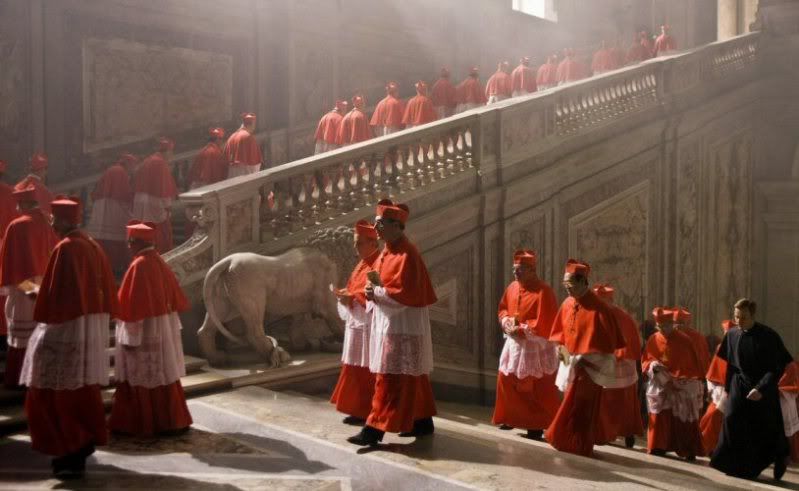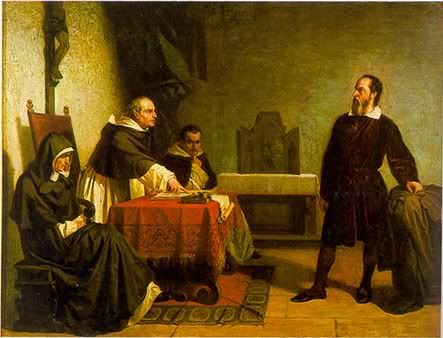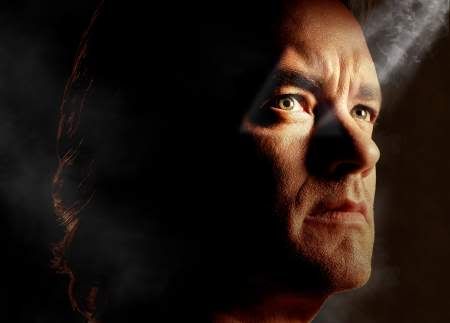
[audio:http://www.blueinkalchemy.com/uploads/angelsndemons.mp3]
When I was studying English at university, I came across a revelation. It was a place full of distractions that could sap the time and energy of the unwary student, and deadlines do not often change based on a hangover or waking up in an unfamiliar place. However, it is possible, under those circumstances, to produce a paper that seems to have been adequately researched even if it was not. I, however, never made the grand assertion that anything I threw together at the 11th hour contained information that was entirely factual. That sort of claim is best left to other authors. Like Dan Brown, for instance. It’s something overshadowing all of his books, as well as the two adaptations of novels to films as of this writing — The DaVinci Code and Angels and Demons.
Of the two, Angels and Demons is better. I didn’t hate it. That would require interest and energy that the movie doesn’t really deserve or earn.

At the Large Hadron Collider, an experiment to harvest antimatter goes exceedingly well, resulting in three clear Pringles cans that magically contain the annihilating substance. One of them is stolen. Meanwhile, in Vatican City, the Pope has died and the cardinals of the Catholic Church are gathering for Conclave, the sealed conference in which they choose the new head of the Church. However, four of the favorites for the throne of St. Peter have been kidnapped. The only clue anyone has is a strange image that seems to be a word – “Illuminati.” Shown the antimatter container’s dying battery and given a ticking clock, the Church turns to someone they know who can unravel the mystery – Harvard symbologist Robert Langdon.
Shedding the embarrassing mullet he sported in his first outing as Langdon, Tom Hanks gives the protagonist his particular form of everyman charm. He places the professor squarely between the quiet earnestness of Ewan MacGregor and the rather seething menace of Stellan Skarsgaard. In general, the performances in Angels & Demons don’t go over the top and do what they can to lend some much needed plausibility to the plot. I do have to say that I was initially disappointed that Audrey Tautou wouldn’t be joining us this time around, but when I saw how superfluous the role of ‘the girl’ was I was glad she didn’t waste her time.

The Catholics definitely know how to liven up a congregational meeting.
Director Ron Howard shoots this movie and frames his scenes rather well. The action is clean, the actors sincere and the dialog uncontrived, save for the occasional spiral into false fact. Dan Brown, from what I understand, is a practicioner of what I will call “shock schlock” – writing that is mediocre at best framed in devices like bad research or a flimsy reinterpretation of classic horror creatures. The marked difference between what the audience knows or expects and what appears in the book is meant to stir up controversy and thus raise interest in the book, thus increasing sales. It’s entirely possible Brown had this purpose in mind when he claimed all the historical “facts” he cites to be “true.” The problem is, they’re not. A quick Google search clears up the inconsistencies that, for me, pretty much ruin the narrative.
Take Galileo, for example. In the film, Langdon tells us that his assertion that the Earth moves around the Sun caused the Church to bully him into recanting his works and releasing books that retracted his earlier writings, only he also released a book in secret that contained “the Truth” and founded the Illuminati. The implication of this Truth’s existence isn’t as damning of the Church as it is in the DaVinci Code and nobody tries to kill Langdon over heliocentricity the way they did over the idea of Christ having a child. The Church has only a limited number of assassins, you see. Anyway, it was a glaring error that threw me for a loop. Let me explain.

Painting by Cristiano Banti, 1857
Galileo Galilei was called before a papal court in 1633 on suspicion of heresey. When Galileo, a devout Catholic, discussed his work with Pope Urban VIII, His Holiness told Galileo to go ahead and write out the arguments for and against heliocentrism, but not to advocate it. Instead, he framed the argument as a narrative definitely in favor of the Earth’s movement and gave the view of the Pope through a character taken by his audience to be a simpleton. In light of this unintended slight, the Inquisition demanded Galileo recant his advocacy. He didn’t. For this he was placed under house arrest for the rest of his life, his books were banned and publication of further works forbidden, and he died alone, penniless and blind. Oh, and the Illuminati? Not founded until 1776.
This is just one example, but it permeates both this work and The DaVinci Code so deliberately and thoroughly that I can’t help but feel Brown is being systematic in his use (or abuse) of history. I do try to judge a film on its own merits regardless of its source material, but there’s so much heavy-handedness in these works it might well have been typed out by someone wearing medieval plate gauntlets. Just as Stephenie Meyer uses defanged vampires and sullen, lackluster werewolves to teach her audience about abstinence and the righteousness of traditional marriage, Brown uses falsified and mis-interpreted historical documentation to elevate science to a sort of divinity while demonizing people of faith. Any faith. But especially Catholicism. He’s one strained metaphor and misquoted date away from having Langdon sparkle in the sunlight.

“THIS IS THE SKIN OF A BOOKWORM, BELLA.”
While Dan Brown seems to be doing his utmost to drive a wedge between science and the Catholic Church, even after the big reveal at the end, the movie doesn’t seem interested in choosing a side. It presents the conflict and depicts the lengths to which the Church may go to defend itself, albeit in a much less heavy-handed manner than The DaVinci Code. Ron Howard’s aim appears to be balancing things out so that the film, on its own narrative, doesn’t declare one side good and the other evil. There’s a truth in that, as while Angels and Demons follows the trend of Brown’s work in using intellectualism to undercut the tenants of faith, Langdon’s presence ends up protecting the very faith he struggles to accept. Not for himself, mind you. He still seems to scoff at anybody who’d even consider the idea of a divine presence, let alone an invisible man controlling every aspect of creation, a viable one. And considering the nature of the work, that’s Brown’s sarcastic, “oh you’re such a child” smirk we’re seeing, not Langdon’s.
To their credit, the screenwriters, actors and director of Angels & Demons manage to keep the messages of the movie from overriding the narrative. The problem with this is, without the deliberately inflammatory nature of the sentiment running under Brown’s prose, there isn’t much here. It feels far too mediocre to illicit the sort of reaction Brown was likely going for. I’m not certain if Brown is deliberately trying to pull people away from the church by painting them as a cadre of supervillains or if his aims are just to make a quick buck with some “shock schlock,” but Howard and his cast completely destroy whatever aim he had by rendering the story of his first Langdon adventure entirely without teeth, power or even much energy. It limps along for its 150 minute run-time, never really rising above the mire of its source material yet treating that material like it’s an embarrassment. Which, let’s face it, it kind of is. Angels and Demons, for all of its star power and bestseller basis, simply can’t be arsed to care enough to tell a good story.
And if it can’t be arsed to care, I can’t be either.
Josh Loomis can’t always make it to the local megaplex, and thus must turn to alternative forms of cinematic entertainment. There might not be overpriced soda pop & over-buttered popcorn, and it’s unclear if this week’s film came in the mail or was delivered via the dark & mysterious tubes of the Internet. Only one thing is certain… IT CAME FROM NETFLIX.

